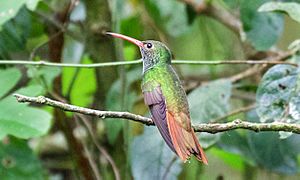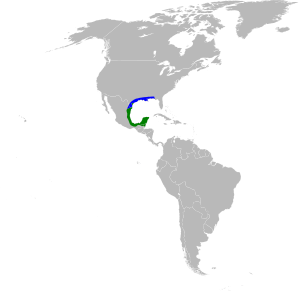Buff-bellied hummingbird facts for kids
Quick facts for kids Buff-bellied hummingbird |
|
|---|---|
 |
|
| Conservation status | |
| Scientific classification | |
| Genus: |
Amazilia
|
| Species: |
yucatanensis
|
 |
|
| Range of A. yucatanensis Wintering range Breeding and wintering range | |
The buff-bellied hummingbird (Amazilia yucatanensis) is a cool, medium-sized hummingbird. These tiny birds are about 10 to 11 centimeters (4 to 4.3 inches) long. They are also very light, weighing only about 4 to 5 grams (0.14 to 0.18 ounces).
Contents
What They Look Like
Adult buff-bellied hummingbirds have shiny, metallic olive green feathers on their backs. Their lower chest and belly are a soft, buffy (light brownish-yellow) color. Their tail and main wing feathers are a reddish-brown, called rufous. The tail is slightly forked, like a "V" shape.
The male hummingbird has a straight, very thin bill (beak). It is mostly red with a darker tip. His throat shines with a metallic golden green color. Female buff-bellied hummingbirds have a darker upper bill. They are also a bit less colorful than the males.
Where They Live and Nest
These hummingbirds live in forests and thick bushes. You can find them from the southern Texas in the United States all the way through the Yucatán Peninsula in eastern Mexico. Their home also extends into northern Belize and northwestern Guatemala in Central America.
They like places with pine-oak forests and dry, scrubby areas. They also enjoy thickets found along watercourses, which are places where water flows.
The female hummingbird builds a nest in a safe spot. This is usually in a shrub or a tree. Both male and female hummingbirds, no matter their age, are very protective. They will bravely defend their feeding spots from other birds. Females usually lay two small, white eggs.
Traveling for Winter
The buff-bellied hummingbird is a migratory bird, but only partly. This means some of them travel for winter, while others might stay put. In winter, you can find small groups of these hummingbirds along the Gulf Coast of the United States. They fly from Texas all the way to the Florida panhandle.
What They Eat
These amazing birds mostly eat nectar from flowers and flowering trees. They use their long, special tongue to reach the sweet nectar deep inside flowers. Besides nectar, they are also skilled hunters. They catch tiny insects right out of the air while flying!
Images for kids
See also
 In Spanish: Amazilia yucateca para niños
In Spanish: Amazilia yucateca para niños






